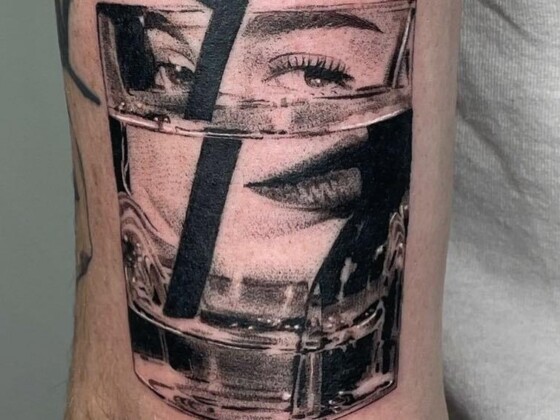Devon Preston
October 30th, 2018
9 Common Tattoo Complications and What To Do About Them
Your Solution For Problem Tattoos
While, in a perfect world, there would be no tattoo problems—this is not the world we are living in. Things go wrong during the tattoo process (or the days that follow) every single day and unless we get the word out, clients will continue to get tattoos with noticeable complications. However, whether it be the fault of the artist or the client, these mistakes are avoidable. Take a look below to learn the 9 most common tattoo complications and what you can do about your issue. Then, if you have experience with one of these tattoo problems, be sure to share your thoughts in the comments section on Facebook.

Blowouts
Blowouts are any unfortunately common tattoo complication that occurs when the artist puts the ink too deep. If the ink is put in too deep it will spread out throughout the layers of the skin. Blowouts are most commonly noticed immediately after a tattoo is finished, however, some take a few weeks to show up. Typically, blowouts occur when a tattooer is inexperienced, but it can also happen if they are too heavy handed.
The only solution for fixing a blowout is with a coverup. However, if the blowout is small, it is possible for the artist to make a few minor adjustments in the tattoo.

Keloids
Keloiding, while mostly uncommon, can occur from a tattoo. Unlike a blowout, keloiding is completely depending on a person’s genetics. Some people, often people with darker skin, are prone to keloiding and should be cautious when getting a tattoo or piercing. It’s more common for keloiding to occur in piercings, but there are cases where it happens as a result of a tattoo.
There is no real way to avoid getting a keloid from a tattoo, but we recommend consulting a tattooer if you’re prone to this type of scarring. Artists with experience working on keloid-prone skin may have different techniques for approaching a tattoo.

Bad Translations
While we highly recommend researching your tattoo, especially if it is in a foreign language to you, not all artists and clients are careful with this. Google translate is not a reliable source for correct translations and in some writing systems, like kanji, it’s easy to make major mistakes.
In order to prevent these mistakes, do your research and if possible, proof your tattoo with someone who if fluent in that language.

White Ink Turning Yellow
White ink, specifically tattoos that entirely consist of white ink, are still largely taboo in the tattoo industry. And here’s why. White ink is extremely prone to turning yellow, especially when exposed to sunlight. Just like your skin, tattoos change colors due to prolonged sun exposure.
The best way to keep your white ink tattoo from yellowing is covering it up when it has the potential to be exposed to direct sunlight. Whether it be through sunblock or clothing, this is the best solution for protecting your white tattoo.

Crooked Ink
There’s nothing worse than a nice tattoo that is crooked or unintentionally asymmetrical. Placement is a key component to tattooing and there’s no excuse for having a design that is noticeably off center. Sure, human bodies are never perfectly symmetrical to begin with, however, an artist should be able to make it work.
In order to avoid a crooked tattoo, make sure you check over the stenciled design multiple times before the needle hits your skin. Additionally, the artist should place the stencil when you’re standing up right and your body is centered.

Misspelled Tattoos
Like poorly translated tattoos, misspellings occur when text is not thoroughly proofed by multiple eyes. It is not the artist’s responsibility to ensure that your tattoo is spelled correctly, it is the job of the client to double, triple, and quadruple check their design.
If you end up with a misspelled tattoo, go back to your artist and see if they can make adjustments to the design. In some cases, the problem can be easily mediated, however, with others a coverup is the only viable option.

Tattoo Infections
Infections are an unfortunate side effect of improper aftercare and they can lead to serious health consequences. After getting a tattoo, your artist will give you a strict lists of dos and don’ts, and its important for clients to trust their professional expertise. But in general to avoid an infection, clients should stay away from bodies of water whether it be a pool or an ocean during the healing process.
If you have an infected tattoo, you need to seek medical attention immediately. There have been serious health consequences because of infected tattoos and some even result in death.

Scarring
Another common tattoo complication is scarring. Scarring occurs when the tattoo needle penetrates beyond the second layer of skin and comes in contact with the deeper, delicate layers. Artists who are heavy handed, inexperienced or straight up lazy are prone to scarring their clients.
Tattoo scarring is largely unfixable and artists need to be extremely careful if they’re tasked with covering up a scarred tattoo. Tattoos are essentially open wounds and an artist can make these scars worse by going over them with a machine.

Fast Fading
Last, but not least, fast fading is one of the most common complications that afflict tattoo clients. All tattoos will fade over time, however, an inexperienced artist or specific styles and locations are prone to rapid fading. If an artist does not go deep enough with their needles, the tattoo will likely fade quickly.
However, certain areas of the body, such as the fingers or the palms of the hand will fade quicker no matter if the tattoo is put in properly. These locations have different skin than the rest of the body and on top of that, they are constantly manipulated through daily use.
There are ways to avoid fast fading, such as enlisting an experienced artist or seeking out a tattooer who specializes in tattooing difficult areas. However, if you have a faded tattoo that needs fixing, your options are to either continuously get the piece touched up or to cover the tattoo with something built to last. Saturated blacks and heavy outlines are shown to withstand the tests of time, even in tricky spots on the body.
Editor's Picks
Chris Brown’s Face Tattoo Shows His Heart and Sole
Chris Brown has a brand new tattoo! Long gone are the days of the baby faced teen, Brown is all grown up and has the tattoo collection to prove it!…
Oh Me, Oh My
Chrissy Chlapecka on finding her voice, spreading self-love on TikTok and releasing her first single













